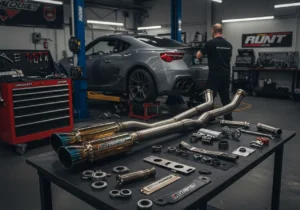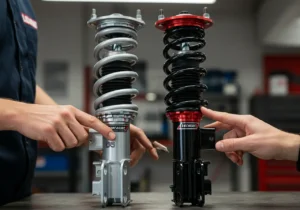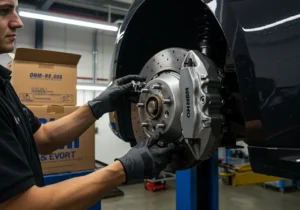When building a high-performance vehicle, every component counts. The debate of “OEM vs Aftermarket Parts: What’s Best for Performance Builds?” is at the core of any serious upgrade project. Understanding your options—and their implications—can mean the difference between achieving peak performance and settling for less.
OEM parts (Original Equipment Manufacturer) are produced by the same company that made your vehicle’s original components. These parts guarantee an exact fit, consistent quality, and seamless integration with existing systems. Aftermarket parts, on the other hand, come from third-party manufacturers and offer a broader range of choices, often at a lower price point. Their compatibility spans multiple makes and models, but quality and fit may vary.
Performance builds demand reliability under stress, precise fitment, and optimal function. The parts you choose directly impact acceleration, handling, durability, and even resale value.
This article breaks down the differences between OEM and aftermarket parts with a focus on performance vehicles. You’ll find clear guidance to help you select components that align with your goals—whether chasing lap times or crafting a unique ride. Expect honest comparisons, practical advice, and real-world considerations to help you make the best choice for your next performance build.
Understanding OEM Parts
Original Equipment Manufacturer (OEM) parts are components built by the same company that supplied the parts for your vehicle when it first left the factory. These manufacturers work directly with automakers, following strict specifications and engineering standards unique to each model.
Advantages of OEM Parts
- Design specificity is a major advantage. OEM parts are engineered for an exact fit, so installation is straightforward and there’s no need for modification.
- OEM quality means every part matches the original in material, dimensions, and performance, maintaining consistency across your build.
- Most OEM components come with OEM warranties, offering protection against defects and giving you peace of mind about both quality and durability.
Choosing OEM ensures that each part works seamlessly within your vehicle’s existing systems. This attention to detail helps preserve resale value and upholds factory safety standards, making OEM the gold standard for those building high-performance vehicles where reliability cannot be compromised.
Exploring Aftermarket Parts
Aftermarket car parts are components produced by independent manufacturers, not affiliated with the original vehicle maker. These third-party auto parts are designed for broad compatibility, fitting a range of makes and models instead of being engineered for a specific vehicle.
1. Manufacturers
The aftermarket industry includes large, reputable brands with global distribution as well as smaller companies focused on niche components. Well-known names like Bosch, Denso, and Magna International provide a wide selection, but the market also includes less established brands whose quality varies.
2. Fitment
Unlike OEM components crafted for an exact match, aftermarket parts prioritize versatility. This approach allows a single part to fit multiple vehicles, but can compromise perfect alignment or optimal integration.
3. Aftermarket Quality Variability
Not all third-party auto parts meet the same standards. Some deliver performance equal to or better than OEM, especially in specialized upgrades, while others fall short in durability and reliability. This variability in quality and fit makes it crucial to evaluate each aftermarket option carefully. It’s essential to weigh the pros and cons of OEM car parts versus aftermarket ones, as this decision can significantly impact your vehicle’s performance and longevity.
 Key Differences Between OEM and Aftermarket Parts
Key Differences Between OEM and Aftermarket Parts
The difference between OEM and aftermarket parts starts with price. OEM parts consistently cost more, often by 20-60%, due to exclusive manufacturer sourcing, branding, and strict quality requirements. Aftermarket parts come in at a lower price point, offering attractive savings for budget-minded enthusiasts or large-scale builds.
Part quality differences
Part quality differences are most apparent in how each component is made and tested. OEM parts pass rigorous quality control and must meet manufacturer specifications for material, fitment, and performance. Every piece matches the original part’s standards, reducing the risk of premature failure or compatibility issues.
Aftermarket parts cover a vast range of quality. Some reputable brands rival—or occasionally exceed—OEM durability through innovative materials or designs. Others cut costs with cheaper materials or looser tolerances. The variation in quality control means results can be inconsistent, especially when prioritizing cost over brand reputation.
The OEM vs Aftermarket Parts: What’s Best for Performance Builds? debate hinges on these factors—budget flexibility versus guaranteed precision and reliability. For those pushing vehicles to their limits, these differences can determine not just cost but long-term success on the road or track.
Impact on Performance Builds
Performance car builds demand more from every component than standard vehicles. The smallest mismatch or weakness in a single part can lead to power losses, handling issues, or even catastrophic failure at high loads.
- Precise fitment becomes critical. When you push your vehicle to its limits, even slight deviations in part dimensions or tolerances can introduce rattles, leaks, or stress points that compromise reliability and safety.
- Durability directly impacts success on the track or street. Inferior materials or inconsistent manufacturing in non-OEM options can result in premature wear—putting your investment and performance goals at risk.
OEM parts are engineered using strict manufacturer standards. Every piece is crash-tested and designed for high-performance compatibility with your specific make and model. This means you get reliable auto parts that work seamlessly together, ensuring optimal power delivery, predictable handling, and long-term durability under extreme driving conditions. For builders aiming for consistency and peak performance, sticking with OEM components removes the guesswork from the equation.
Factors to Consider When Choosing Between OEM and Aftermarket Parts
When choosing car parts for performance builds, several factors come into play. A critical consideration is the trade-off between budget constraints and the longevity and reliability of the parts.
 OEM vs Aftermarket: Understanding the Difference
OEM vs Aftermarket: Understanding the Difference
OEM parts generally come with a higher price tag due to their superior quality and precise fitment, which can ensure long-term durability. This makes them suitable for those prioritizing longevity and reliability.
On the other hand, aftermarket parts offer cost-saving opportunities but may vary in quality. Selecting high-quality aftermarket options requires thorough research to avoid compromising performance.
Maintaining Warranties: The Impact of Part Choice
Another crucial factor is maintaining existing vehicle warranties. Using OEM parts often preserves these warranties, safeguarding against potential issues. In contrast, while some aftermarket parts might be more affordable, they could void the dealer’s warranty if they cause problems.
Key Considerations in Your Decision-Making Process
When deciding between OEM and aftermarket parts, keep the following factors in mind:
- Budget constraints: Evaluate whether the cost savings of aftermarket parts outweigh potential risks.
- Part longevity and reliability: Determine if the initial investment in OEM parts translates to better long-term value.
- Warranty preservation: Consider how part choice impacts existing vehicle warranties and future repair costs.
Common Myths and Misconceptions About OEM and Aftermarket Parts
Understanding the common myths about car parts quality is crucial when deciding between OEM vs Aftermarket Parts: What’s Best for Performance Builds?
Myth 1: All Aftermarket Parts Are Inferior
Reality: Not all aftermarket parts are of lower quality. Many aftermarket manufacturers produce high-quality components that can rival or even surpass OEM standards. Thorough research and selecting reputable brands can yield dependable parts suitable for performance builds.
Myth 2: All OEM Parts Are Prohibitively Expensive
Reality: While OEM parts often come at a premium, they guarantee precise fitment and durability. However, there are instances where aftermarket alternatives offer cost-effective solutions without significant compromises in quality, especially for non-critical components.
Warranty Concerns
Clarification: Properly installed aftermarket parts do not automatically void warranties. The Magnuson-Moss Warranty Act protects consumers, ensuring that vehicle warranties cannot be voided solely due to the use of aftermarket parts unless it can be proven that these parts caused the issue. Always ensure professional installation to maintain warranty integrity.
 Tips for Selecting High-Quality Aftermarket Parts (If Opted)
Tips for Selecting High-Quality Aftermarket Parts (If Opted)
Choosing quality aftermarket auto parts requires careful attention and a commitment to avoiding common mistakes. Not all aftermarket parts are created equal, so it’s important to do your research before making a purchase.
1. Research Brand Reputation
Start by looking for brands that have a proven track record. Established manufacturers usually provide better quality assurance than unknown alternatives.
- Check automotive forums and review sites for user experiences.
- Look for brands that offer clear warranty terms or satisfaction guarantees.
- Prioritize companies with transparent manufacturing processes and third-party certifications.
2. Read Verified Reviews
Customer reviews can reveal recurring issues, fitment problems, or exceptional reliability. Seek out detailed feedback rather than focusing solely on star ratings.
3. Verify Vehicle Compatibility
Avoid costly mistakes by ensuring the part fits your exact make, model, and year.
- Use manufacturer part numbers as cross-references.
- Consult compatibility charts on reputable seller websites.
- When possible, reach out to customer support or the seller for confirmation before buying.
4. Assess Return Policies
Reliable sellers typically offer flexible return options in case of fitment issues or product defects, reducing risk during purchase.
By following this methodical approach, you can choose quality aftermarket auto parts that will help you avoid premature failures and unnecessary expenses, keeping your performance build project on track.
Conclusion
Choosing between OEM and aftermarket parts for performance builds depends on your specific goals and budget. It’s important to prioritize reliability and optimal operation, as the best auto parts for performance builds should ensure both safety and peak functionality.
Key takeaways:
- OEM Parts: Offer guaranteed fit, superior quality, and durability. They are often backed by warranties but come at a higher price point.
- Aftermarket Parts: Provide more variety and cost savings, but require diligent research to avoid inferior quality that might compromise performance or longevity.
Carefully assess your build goals—whether you seek the assurance of OEM parts or the flexibility of aftermarket options. Making informed decisions will help you achieve the best results for your performance vehicle.

 Key Differences Between OEM and Aftermarket Parts
Key Differences Between OEM and Aftermarket Parts OEM vs Aftermarket: Understanding the Difference
OEM vs Aftermarket: Understanding the Difference Tips for Selecting High-Quality Aftermarket Parts (If Opted)
Tips for Selecting High-Quality Aftermarket Parts (If Opted)